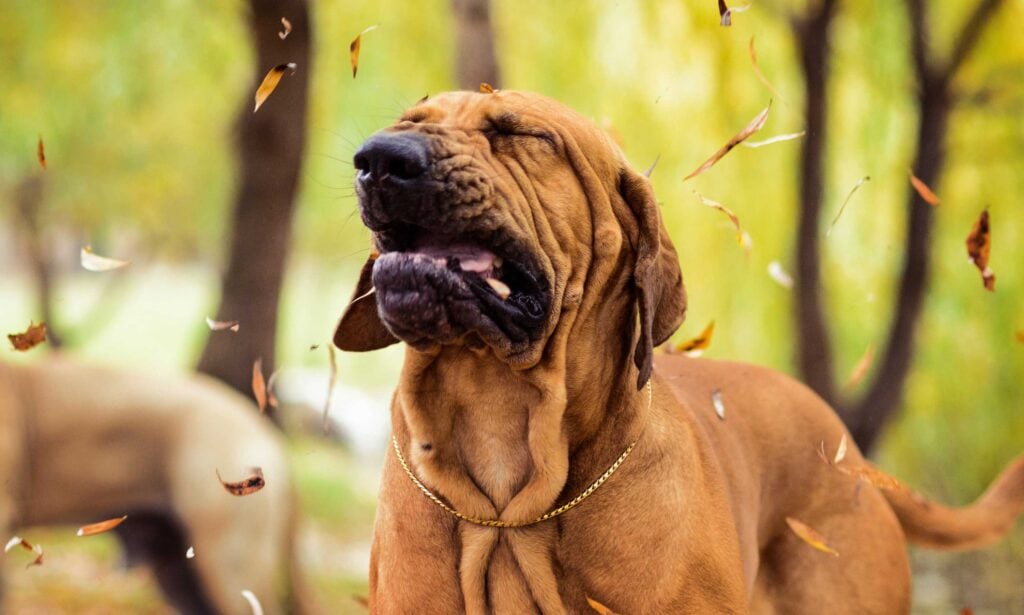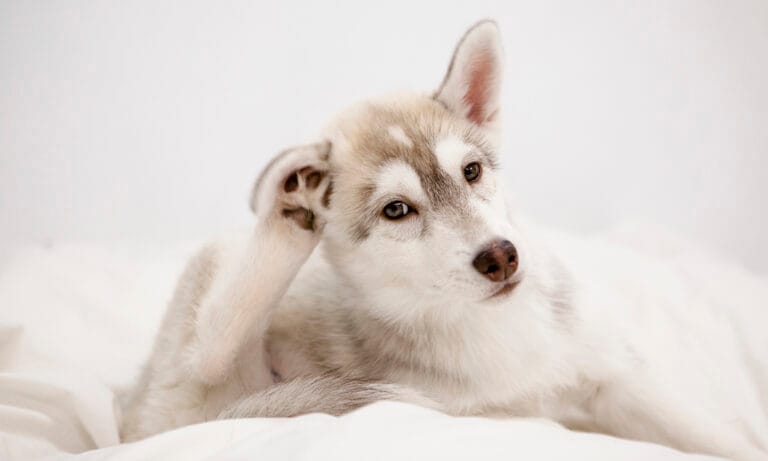Fall brings a lot of beauty, but it can also bring changes in your pet’s health. Just like humans, dogs can be sensitive to shifts in the environment, and you might notice excessive scratching, sneezing or just general discomfort in your pup. These signs can all point to fall allergies in dogs.
And while your dog may be reacting to a number of things, there are four culprits that are the most likely. We spoke to a vet expert all about fall allergies in dogs.
Click to jump to each section:
4 Common Fall Allergies in Dogs
1Ragweed

Symptoms
Pet parents may notice the following symptoms:
- Excessive scratching
- Excessive biting
- Excessive chewing
Common locations of itch include:
- Forelimbs
- Paws
- Armpits
- Facial areas
Secondary ear infections are common as well, Dr. Hinsperger says.
Treatment
If your dog develops symptoms, treatment involves breaking the itch cycle, Dr. Hinsperger says.
A vet may prescribe a combination of therapies, including shampoos, topical medications, oral medications (corticosteroids, Apoquel) or injectable treatments (Cytopoint).
It’s difficult to prevent exposure to ragweed because it releases pollen, but you can help reduce your dog’s contact by keeping them indoors during peak season (mid-September), keeping the windows closed and using air purifiers.
2Mold

Mold is always around, both indoors and outdoors, but it can be especially prevalent in the fall.
The dampness of the season can trigger more rapid growth, and piles of leaves on the ground and other decaying plant material are the perfect breeding grounds for the fungus.
Symptoms
Mold allergies trigger symptoms, like skin irritation, that are similar to other environmental allergens—but respiratory distress is also a hallmark sign.
The most common symptoms of mold allergies are:
- Excessive itching and scratching
- Red and/or scaly skin
- Thickened skin
- Hot spots and skin infections
- Chewing on paws
- Ear infections and/or shaking of the head
- Hair loss
- Sneezing, wheezing and/or labored breathing
- Watery eyes
- Runny nose
Treatment
Like other pet allergies, treatment for mold involves removing the trigger, if possible. Try the following:
- Keep your dog out of leaf piles.
- Set up a dehumidifier in your home if it feels damp.
- Consult with a mold remediation expert to rectify the problem, if you suspect mold in your home. Mold allergies can affect both dogs and humans, and chronic exposure can cause more serious problems than fall allergy symptoms.
Your vet may also prescribe medications to treat an active allergic reaction, clear up any concurrent ear infections and/or help improve labored breathing.
3Dust Mites

Dust and dust mites are other common fall allergens.
They’re often kicked up into the air when the heating elements in your home are turned on for the first time, but dust mites are so tiny you can’t see them.
They can also become more of a problem when you’re spending more time inside.
Symptoms
Symptoms of a dust-mite allergy can include:
- Itchy skin
- Rash and inflammation
- Red and/or oozing skin
- Excess licking and/or scratching
- Watery eyes and nose
- Sneezing or coughing
- Difficulty breathing (in severe cases)
Dust mite allergies are often mistaken for chronic conditions, like atopic dermatitis, because they can be difficult to diagnose and treat. But respiratory symptoms are a characteristic sign that don’t occur with other chronic skin allergies.
Treatment
The first step for getting rid of symptoms is to treat the skin with corticosteroids, antihistamines and other topical ointments.
You can also bathe your dog in cool water with a medicated shampoo to reduce the risk of infection and alleviate itching.
It’s also important to vacuum as much as possible, and regularly wash dog beds, sheets, pillows and anything else your dog comes in contact with in hot water to kill dust mites and remove allergens.
4Fleas

Fleas can be a nuisance all year, but fall is one of the worst times for infestations. They thrive in cooler, damper weather—a hallmark of fall.
Not every dog has a true flea allergy, which is clinically referred to as flea-allergy dermatitis, or FAD. But dogs who have environmental allergies are more likely to have an allergic reaction to a flea bite.
Symptoms
The characteristic signs of a flea allergy are:
- Itchy skin
- Hair loss
Skin and blood tests can confirm (or rule out) whether this is the cause of your dog’s symptoms.
Treatment
Treatment for flea allergies involves flea control and symptom management.
If your dog is really uncomfortable, your vet may recommend topical ointments to help reduce itching in the short term. But ultimately, the only way to clear up a flea allergy is to get rid of the fleas.
You’ll have to treat your dog for an active infestation and likely treat your home with flea powder (like Adams Flea & Tick Carpet Powder) as well.
Once the infestation is cleared up, oral and/or topical flea prevention is vital to help prevent recurring problems.
Here are the best flea treatments for dogs, according to pet parents.
Diagnosing Fall Allergies in Dogs
Environmental allergies are a common concern, but they’re not the only thing that can cause itchy skin or ear infections. Your dog may be dealing with other underlying health problems that are causing similar symptoms.
Because of this, it’s important to get a proper diagnosis from your vet to rule out other potential causes.
Diagnosing fall allergies in dogs is a multistep process that looks at the dog’s history, clinical signs and time of year. It also involves ruling out other causes of itchiness, Dr. Hinsperger says.
“In very severe cases, we would perform allergy testing to determine what allergens are affecting the patient,” he adds. “We can then formulate immunotherapy (allergy shots) targeting those particular allergens.”
Preventing and Managing Your Dog’s Fall Allergies

Dr. Hinsperger says there are no definitive ways to prevent fall allergies in dogs, but there are some things you can do to reduce the chances of your pup developing symptoms.
Avoid Allergens
Identifying and avoiding potential triggers is the best method to prevent symptoms. But this isn’t always possible, especially for things like dust mites that are prevalent and impossible to see.
Start an Antihistamine Early
If you already know your dog gets allergy symptoms in the fall, starting an anti-allergy medication prior to the onset can be beneficial, Dr. Hinsperger says.
Time Vaccinations Accordingly
Being more strategic with vaccinations may also help.
“Avoid vaccinating during the peak allergy seasons, such as the spring and the fall,” Dr. Hinsperger says.
“Vaccination will stimulate the immune system, and given that allergies are related to the immune system, vaccinating during the off-season can be beneficial.”
Consider Hypoallergenic Dog Food
Food might not be causing your dog’s allergies, but it can make symptoms worse.
“Many dogs that have seasonal allergies can also have concurrent food allergies,” says Dr. Hinsperger. “Controlling what you can, such as the food, can reduce the symptoms of fall allergies.”
If your pup does start to exhibit signs of allergies, you can help soothe your dog’s skin and make them more comfortable.
Ask your veterinarian what dog food they recommend.
Reduce the Itch
The first step is ensuring your dog’s comfort.
“We often need to use anti-allergy therapy to reduce the itch, discomfort and secondary infections,” says Dr. Hinsperger.
You can try over-the-counter corticosteroids or prescription medications like Apoquel and Cytopoint.
The best course of action is to ask what your veterinarian recommends.
Bathe in Cool Water
During the allergy seasons, bathing with cool water every few days with a regular non-fragranced shampoo can be beneficial, says Dr. Hinsperger.
“It will help reduce the amount of surface pollens and contaminants on the skin,” he says.
Add Fish Oil to Your Dog’s Diet
Supplementing with omega-3 fatty acids can be beneficial, thanks to their anti-inflammatory effects, Dr. Hinsperger says.
You can mix an oil, like the Vibeful Omega-3 Fish Oil, directly into your dog’s food, or give them an omega-rich treat, like the NaturVet Scoopables.
Again, ask your vet what they recommend.
FAQs about Fall Allergies in Dogs
Q:
What months are the worst for dog allergies?
Q:
How long does fall allergy season last for dogs?
Q:
Can I give my dog Benadryl for allergies?
A:You can give your dog Benadryl, Dr. Hinsperger says, but there are some things to consider.
“Antihistamines are only effective when started prior to the onset of symptoms or when the symptoms just start,” he says. “The typical dose would be 2 to 3 milligrams per kilogram of body weight every eight to 12 hours.”
More on dog allergies:
Share:

















